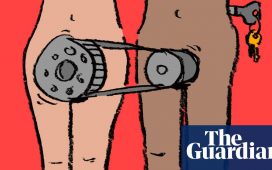As a working mother, one word has saved me as the pandemic has worn on: “No.” I’ve learned to say “no” to being the parent who will automatically take carer’s leave when childcare centres and schools close. “No” to being the only one to plan meals for the week. “No” to being the type of Instagram-worthy mother who mindfully makes her own hummus throughout lockdown.
Mastering the word has been liberating. It has freed up time, energy and headspace to do my paid work, focus on self-care essentials and actually enjoy free time with my family. It’s also supported a positive relationship with my partner because we both equally pull our weight at home, heading off the resentment that can fester in some relationships when the unequal division of labour takes its toll.
The hardest word
The road to learning to say no at home has been a long one. It’s taken me the past 18 months; it is a path I embarked on after I recovered from a severe case of burnout and realised my inability to say the word was making me sick.
What I’ve learned is that for such a small word, no can be an incredibly difficult word to say for women, who are taught from infancy to be agreeable and accommodating. This “tyranny of niceness”, as Helen Lewis has called it, stops many women from drawing boundaries, pushing back – and saying no when we really need or want to.
Instead, we so often say “yes” to favours, requests and unrealistic parenting expectations because we fear being accused of being rude, mean or – shock horror – selfish (one of the worst things you can call a woman in our culture that fetishises female self-sacrifice).
Even writing this, I’m sorely aware that some readers will take issue with my decision to factor my own wellbeing into the mix when deciding whether to say yes to domestic work.
But women desperately need the word no – especially working mothers, who are among the most time-poor people in the world. That’s never been more so the case than in the midst of Covid, as has been made depressingly clear by the steady stream of bleak statistics we keep hearing about the gendered impacts of the pandemic.
Working mothers are not only paid less than men and childless women – and more at risk of job insecurity – they have also shouldered the majority of the burden around home learning and childcare during lockdowns across the world.
Under this sort of time pressure, it’s no surprise that working mothers experience more severe mental-health consequences than our male counterparts. Research out of Monash University has found that women are more likely than men to have clinically significant symptoms of depression and anxiety during lockdown – with the researchers concluding that caring responsibilities “contributed significantly to the risk of symptoms of depression and anxiety”.
Of course, learning to say no isn’t a silver bullet for the time pressures on women, nor the unequal division of labour in the home. It won’t solve systemic issues such as the gender pay gap, the deeply ingrained societal expectation that women be primary carers and the double standard that sees women penalised for being assertive.
But saying ‘no’ at home is a start. In a world where we each have very little control over the larger picture, we can at least draw boundaries around what we can and cannot take on in our own domestic partnerships.
The three approaches below can get you started. A quick heads-up: these tips are primarily geared towards women in heterosexual relationships, because the unequal division of labour shows up most clearly in male-female partnerships and once children enter the picture.

The parenting
A candid conversation with your partner about division of labour is a good way to ease into saying no to taking on more than your share.
This can start with a discussion about the assumptions you might both have about who does what in the home, according to psychologist Justine Alter, who specialises in life transitions and work-life balance.
One assumption to pay particular attention to? That the mother should always be the primary parent – the one who takes a day of leave when the baby’s sick. Or the one who keeps tabs on which groceries to buy, which family telehealth appointments to book, and which click and collect library books to return.
Your next step: discuss whether you want to try to flip that assumption in your household. Feel free to spell out, calmly but firmly, that you’re not willing to be the (only) default parent – that you want and need to say no to being the sole keeper of the grocery/appointment/library book lists.
The chores
Hopefully your partner, like mine, is on board – in theory at least – with the idea that both parents should be involved in unpaid domestic work and childrearing.
The trickier bit can be actually dividing up those household chores, and in particular, the “mental load” – the unpaid work that falls to mothers involving the knowing what needs to be done, the anticipating of chores and events that are coming up, and the planning for them.
One way to get around this: take a cue from Eve Rodsky, who suggests in her book Fair Play that couples sit down and make a list of all the tasks that go into keeping your household up and running. Try not to see this as a point-scoring exercise, but as a way of getting clear on who has time and energy to spare, and dividing tasks up in whatever way makes sense for you and your family.
Once the tasks are divided up, Rodsky suggests, each partner should take complete responsibility for his or her tasks, from beginning to end.
So if one partner is responsible for making your child’s birthday cake, they can’t expect the other to plan and purchase everything they’ll need for the baking (if they ask, you know the answer: no). Instead, they have to choose a cake recipe, know about family allergies, check what ingredients they need, buy the relevant ingredients, know where the cake pan is, bake and decorate the cake, then rustle up some candles and a lighter.
It is important to resist the urge to “gatekeep” the chores assigned to your partner – a common trap that just keeps women locked in the role of mental load-bearer. They can make the damn cake however they like.
The priorities
When dividing up tasks, you’ll also need to get militant about prioritisation – and be open to dropping some tasks off the family to-do list altogether.
Not sure which tasks to prioritise? The best advice I’ve read on this, I picked up from a thread on Twitter. It suggested the trick to juggling different responsibilities and tasks is to think of each of the balls you have in the air as either plastic or glass: you can afford to drop a plastic ball, because it bounces and stays in one piece – but if you drop a glass ball, it shatters irreparably. The trick is to distinguish between which balls are plastic and which are glass, then focus on catching the glass ones.

Plastic balls I’ve felt free to drop (or say a great big no to) include hand-making costumes for Book Week, making sure my daughter’s clothes are always clean and matching, and making the beds in the morning.
Glass balls, for me, include making time for soothing cuddles when my daughter is hurt or scared, making sure she gets vaccinated on time, and prioritising time for books before bed.
Unsustainable pressure
In a world where being accommodating – saying yes – is drilled into women from girlhood, saying no at home can feel jarring at first.
But women are stressed, burned out, anxious and depressed – and the current level of time pressure working mothers are facing, during lockdowns in particular, simply isn’t sustainable.
Saying no at home won’t solve all the gendered implications of the pandemic. But it can carve out small pockets of time, space and peace in our partnerships and homes, creating space for mental calm and enjoyment – and that’s worth saying yes to, surely.














